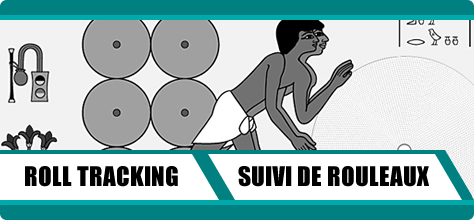
HISTOIRE DU SUIVI DE ROULEAUX
Qu'est-ce que le suivi de rouleaux, en fait?
Le "suivi de rouleaux" est le processus de suivre les produits de papier à travers une usine et un entrepôt de papier. Sans un suivi précis des rouleaux, les usines produiraient trop ou pas assez de papier pour remplir les commandes, causant un gaspillage significatif de capacité de production et une réduction de la qualité du service à la clientèle. La réduction du gaspillage est cruciale pour faire en sorte qu'une usine préserve son avantage concurrentiel sur le marché.
Informatisez-le!
On a assisté au milieu des années 70 à la naissance du suivi informatisé des produits. La compagnie MDDC a automatisé le processus en utilisant les micro-ordinateurs General Automation. Comme c'était le cas de plusieurs des premiers ordinateurs, systèmes gros et coûteux exécutaient leurs tâches à l'aide d'une mémoire vive de 16 kilo-octets et des piles de disque de 5 méga-octets! C'est plus que légèrement sous-alimenté comparé aux OP typiques d'aujourd'hui avec leur minimum de 512 méga-octets de de mémoire vive et 80 gigaoctets d'espace sur le disque dur.
Depuis la naissance du suivi de produit informatisé, la technologie a évolué dans deux directions. Certains systèmes ont augmenté leur capacité soit vers le super-mini, soit vers le macro-ordinateur; tandis que d'autres systèmes se sont réduits aux micro-ordinateurs. C'est un processus de redimensionnement approprié. Les systèmes de suivi de rouleaux sont pour l'industrie du papier ce que d'autres industries appellent communément un "Système d'exécution manufacturière" (MES en anglais). Des expressions antérieures comprenaient Fabrication assistée par ordinateur intégré (FAOI) ou Fabrication assistée par ordinateur (FAO).
Évolution
Avant l'informatisation, les usines identifiaient souvent les rouleaux de papier en leur assignant des numéros séquentiels. Chaque rouleau était pesé et son poids et son numéro de rouleau étaient enregistrés manuellement. Cette information était ensuite imprimée à l'aide d'un stencil ou d'un tampon encreur sur une étiquette qui était ensuite collée sur le rouleau. La seule façon de retracer la filiation ou l'information sur la qualité d'un rouleau était de chercher cette information dans des registres de production créés et mis à jour manuellement. L'effort requis indiquait clairement un besoin d'automatisation. L'automatisation a débuté dans les années 70 alors que certaines usines de papier ont commencé à utiliser un gros système d'impression mécanique, le Magna Printer. Placé directement sur la ligne d'emballage, ces gros mammouths utilisaient des moteurs pas-à-pas pour tourner des tampons encreurs énormes qui étampaient l'information sur de grandes étiquettes qui étaient collées sur les rouleaux.
Amélioration
L'amélioration de l'automatisation a donné lieu au remplacement de ces imprimantes en grande partie mécaniques par des imprimantes modernes matricielles. Ces nouvelles imprimantes produisaient des étiquettes plus attrayantes et plus lisibles, tout en réduisant nettement les coûts d'entretien. Aujourd'hui il y a une vaste gamme d'imprimantes, y compris matricielles, laser, et à transfert thermique, capables de produire de belles étiquettes plurilingues avec données en codes à barres et du graphisme assisté par ordinateur.
Afin de minimiser l'entrée de données, les systèmes conservaient l'information sur les clients et les commandes, libérant ainsi les opérateurs qui n'avaient plus à entrer de nouveau cette information pour chaque rouleau tout au long du processus. Avec les données de la commande déjà dans l'ordinateur, on développait peu après des moyens d'utiliser toute cette information emmagasinée pour établir efficacement l'horaire des machines à papier et pour gérer la production et l'inventaire. Avec le développement d'une gestion d'inventaire précise, les systèmes se sont ensuite tournés vers l'expédition. En plus des rapports de production exacts, les systèmes ont commencé à recueillir de l'information sur la qualité des produits à partir de divers systèmes d'information de transformation du système de commande réparti (DCS) et de laboratoires de qualité. La communication des exigences de finition du client au contrôleur programmable de la ligne d'emballage complétait l'automatisation.
Wrapmation s'engage à poursuivre le développement et à moderniser ces systèmes.
Les systèmes de suivi de rouleaux modernes sont infiniment plus puissants que leurs ancètres de suivi de produit. Les usines de papier augmentent leur efficacité et réduisent leurs coûts en utilisant des systèmes modernes qui fonctionnent sur des postes de travail OP en réseau. Au cours des cinq dernières années, on a vu la croissance des progiciels de gestion intégrés (ERP). Les usines de papier ne font pas exception, et Wrapmation était prête à intégrer la production aux systèmes ERP, fournissant une information sur la production exacte et à jour qui est partagée avec d'autres données essentielles à l'entreprise.
Les bénéfices
Les systèmes de suivi de rouleaux ont procuré:
-
Meilleur ordonnancement, productivité et rendement accrus, assurant une conformité plus solide aux promesses de livraison au client
-
Capacité améliorée de gestion et réduction du gaspillage
-
Contrôle de qualité et suivi améliorés des rouleaux et des palettes
-
Logistique plus efficace avec moins d'erreurs
-
Habileté à gérer presque toutes les attentes des clients
- Personnel de l'usine habilité à prendre des décisions informées, basées sur des données en temps réel